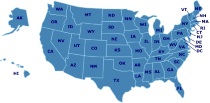Ecology/Conservation
Protecting the Earth for future generations takes first learning about our planet, the environment, and how the ecosystem works. Get ecology teaching tips, project ideas, and more.
Things to See & Do in Oklahoma
Chickasaw National Recreation Area
The “Peaceful Valley of Rippling Waters” appropriately describes Chickasaw National Recreation Area, as it is known for its many mineral springs, cool water, flora, fauna, and wildlife. Here one’s mind may wander back in time to when the early American Indian came to this area to rest, relax at the water’s edge, and hunt for their food from the abundant wildlife. This area has significant geological and hydrological features and lies in the transitional ecotones of the Eastern deciduous forest and the Western prairies.
Tulsa Zoo and Living Museum
The Tulsa Zoo is located on 78 acres within Mohawk Park, which is the third largest municipal park in the United States. Currently, nearly 1,500 animals (436 species) are on exhibit, many of them rare and endangered.
Oakhill Center for Rare & Endangered Species
Oakhill Center is a conservation center in Luther, dedicated to long term conservation of rare & endangered species through propogation & education. Animals include the Snow leopard, clouded leopard, cheetah, Amur leopard & the Persian leopard.
Oklahoma City Zoological Park
Learn about the animal world at the Oklahoma City Zoo. You'll find animal exhibits, special exhibits, and educational programs. Highlights include the Cat Forest and Lion Overlook, Great EscAPE, and a Butterfly Garden.
Activities & Experiments
ExploraVision
ExploraVision is a competition for all students in grades K-12 attending a school in the U.S., Canada, U.S. Territory or a Department of Defense school. Homeschooled students are eligible to enter. It is designed to encourage students to combine their imagination with their knowledge of science and technology to explore visions of the future. Teams of students select a technology, research how it works and why it was invented, and then project how that technology may change in the future. They must then identify what breakthroughs are required for their vision to become a reality and describe the positive and negative consequences of their technology on society. Winning ideas have focused on things as simple as ballpoint pens and as complex as satellite communications. The student teams write a paper and draw a series of Web page graphics to describe their idea. Regional winners make a Web site and a prototype of their future vision.
How I Teach a Large Family in a Relaxed, Classical Way: Science
Family style learning is a great way to tackle lots of different subjects, including science.
Handbook of Nature Study
Based on Charlotte Mason's method of education, this website offers ideas and resources for incorporation nature study into your homeschool.
Arbor Day National Poster Contest
Join over 74,000 fifth grade classrooms and home schools across America in the Arbor Day National Poster Contest. The theme chosen will increase your students’ knowledge of how trees produce and conserve energy. The free Activity Guide includes activities to use with fifth grade students to teach the importance of trees in producing and conserving energy. These activities correlate with National Science and Social Study Standards. The Guide also includes all of the information you need for poster contest participation.
Featured Resources
As an Amazon Associate, we earn from qualifying purchases. We get commissions for purchases made through links on this site.
The Letter Factory Game
Teaches Phonics! The race is on! With two games in one, children play together and learn letter names and sounds with actions and music. Wacky Professor Quigley guides players every step of the way so no reading is required! Games automatically adjust to skill level, to keep children learning at just the right pace! 2 Games in 1: Counting Colors & Letters: Learn letter names and sounds by matching color cards to move around the board. Leaping Letters: Listen to the name or sound and then find th...
A History of Science
A History of Science is not a textbook, but is a guide to help parents and children study science through literature. It is intended for children in elementary grades.
National Geographic Guide to the National Parks of the United States, Fourth Edition
Now in its fourth edition, the National Geographic Field Guide to the Birds of North America is the ultimate birder’s field guide. Sturdy, portable, and easy-to-use, it features the most complete information available on every bird species known to North America. This revised edition features 250 completely updated range maps, new plumage and species classification information, specially commissioned full-color illustrations, and a superb new index that allows birders in the field to quickl...
Only Child: Writers on the Singular Joys and Solitary Sorrows of Growing Up Solo
Only children don’t have to share bedrooms, toys, or the backseat of a car. They don’t have to share allowances, inheritances, or their parents’ attention. But when they get into trouble, they can’t just blame their imaginary friends. In Only Child, twenty-one acclaimed writers tell the truth about life without siblings—the bliss of solitude, the ache of loneliness, and everything in between.In this unprecedented collection, writers like Judith Thurman, Kathryn Harrison, John Hodgman, and Peter ...
Maria Montessori: Her Life and Work
Maria Montessori is important background reading for parents considering Montessori education for their children, as well as for those training to become Montessori teachers. The first woman to win a degree as a Doctor of Medicine in Italy in 1896, Maria Montessori's mission to improve children's education began in the slums of Rome in 1907, and continued throughout her lifetime. Her insights into the minds of children led her to develop prepared environments and other tools and devices that ha...




